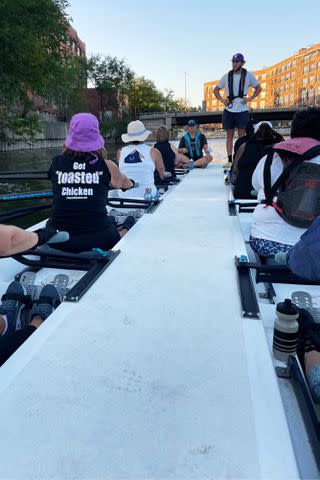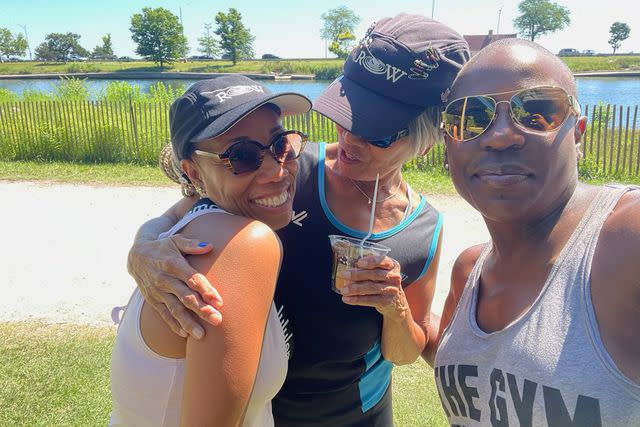How This Nonprofit Rowing Club Helps Breast Cancer Patients Build Confidence and Community
By taking to the water, these rowers have found support, structure, and autonomy during and after their diagnoses.

Standing on the south branch of the Chicago River in 2016, Tara Hoffmann was slightly intimidated as she watched a boat of novice rowers navigate the water taxis and nautical traffic.
“It seemed a little nuts,” she recalls. “But at the same time, I was hooked. I knew I was going to come back, and I knew I wanted to be in that boat.”
In fact, the prospect of rowing down the busy thoroughfare wasn’t even the toughest challenge Hoffmann had faced recently. Earlier that year, she had been diagnosed with breast cancer at a routine mammogram screening, and during her treatment, one of her physicians suggested that she check out an organization called Recovery on Water (ROW), a Chicago-based rowing team for breast cancer patients and survivors. Soon after observing her first practice, Hoffman joined ROW, and today, she serves as the organization’s executive director.
:
With year-round programming, ROW offers in-person and virtual workouts seven days a week. Members in Chicago can participate in outdoor rowing practices and competitions throughout the spring, summer, and fall, and when the infamous winter hits, members can retreat indoors for indoor team practices on rowing machines (an option that’s available year-round as well).

Here’s how ROW has become a safe haven for those with breast cancer — and how the organization is working to reflect the diverse groups that are diagnosed with breast cancer through inclusive outreach efforts.
How Rowing Benefits Breast Cancer Patients and Survivors
Contrary to what you might guess, most ROW members have never picked up an oar in their lives — and some don’t even know how to swim, says Hoffmann. No matter: One of the first things Hoffman emphasizes to potential new athletes is that for many current team members, ROW is their first-ever experience with organized team sports.
“Identifying as an athlete can be very new for our crew members,” she explains. And with rowing’s reputation as a physically taxing, full-body workout, many are understandably nervous about being the new kid on the block.
So why choose rowing as the foundation of this team, rather than a more familiar activity such as running or biking? Sharing that beginners’ journey is a big part of what binds members together, says Hoffmann. “[Rowing] levels the playing field because no one learned it on the playground,” she explains. “Few people are coming with previous experience.” Plus, the team element of rowing ensures that nobody feels singled out or individually responsible for the team’s success, she adds.
Rowing is also physically accessible to many people, regardless of their previous fitness experience, according to Hoffman. “It’s one of the things that’s kind of magical about rowing,” she explains. “It’s very scalable and very accessible, plus it’s low-impact, easy on the joints, and very efficient,” noting that the ROW team members range in age from 30 to 70 years old.
:
Of course, rowing has many physical benefits as well. Rowing can improve aerobic fitness, and it offers a full-body workout, as Shape previously reported. Crucially, for breast cancer patients and survivors, participating in physical activity after an early-stage cancer diagnosis is associated with a reduction in the risk of metastatic disease recurrence and mortality, according to Exercise and Sport Sciences Reviews.
While physical activity isn’t a silver bullet for preventing cancer recurrence, Hoffman and the ROW team believe whole-heartedly in the healing effects of movement. “I think a lot of patients, survivors, and family members are shocked when the idea of exercising during treatment comes up,” she says. “But [exercise] is kind of the perfect prescription for dealing with that laundry list of side effects,” such as nausea, fatigue, muscle atrophy, lymphoma, and range of motion issues, according to Current Sports Medical Reports. (To be safe, every ROW member must be cleared by their doctor before participating in practice, and before each practice, members check in with a coach to debrief on how their bodies are feeling and what level of activity they’re ready to handle.)

Finally, taking on rowing gives breast cancer survivors and patients confidence and a sense of control — in terms of what they can accomplish and how they can impact their own recovery. “I had felt very passive as a patient,” notes Hoffmann. “I was thrilled to be directed to ROW, since it was something that I could focus my energy on to get the best outcomes in cancer treatment.”
That sense of learning something new (and succeeding at it) can have a major ripple effect. “I was 43 when I was diagnosed, and I felt like making changes in my life had become a little hard,” she reveals. “But if I could learn a sport at this stage in my life, I could make changes in other areas of life as well. That empowerment and knowing that learning is possible at all ages is a big deal.”
:
How ROW Wants to ‘Reflect the True Face of Breast Cancer’
After skin cancer, breast cancer is the most common cancer in women in the United States, accounting for about 30 percent of all new female cancers each year, according to the American Cancer Society. Although breast cancer mortality rates have declined over the past 30 years, Black women have a 40 percent higher mortality rate than white women do, as Shape previously reported.
To help close this gap, ROW is focused on connecting with like-minded community organizations to “reflect the true face of breast cancer” and ensure that the rowing team is accessible to all races, backgrounds, and socioeconomic statuses, says Hoffman. "Increasing the accessibility of ROW programs and intentionally welcoming underserved communities to participate and benefit is a strategic pillar of the ROW organization," she expands. "That work...will be a focus of the organization in 2023." They'll start by identifying social support networks that already exist in Chicago’s underserved communities (some of whom they've already connected with), then creating long-term, meaningful partnerships. Over time, these partner organizations can refer anyone already using their services to ROW if the individual might benefit from the team camaraderie and physical challenge.
To ensure that rowing (an expensive sport to participate in regularly) remains accessible for all interested athletes, ROW minimizes member costs, which would typically cover equipment, practice space, coaching fees, boat repairs, and more. With year-round fundraising, grants, donations, and scholarships, the ROW leadership team is able to offer targeted, year-round programming.

In addition, ROW has anti-discrimination practices in place to ensure members are never evaluated based on body type, current fitness habits, or existing conditions. The organization works with coaches and medical teams to identify potential limitations and appropriate modifications for individuals. No matter what athletes are dealing with, there’s often a way to work around it — and they’re probably not the only ROW member with that particular circumstance, stresses Hoffmann.
Finally, while the majority of their time might be spent together training, the members of ROW take that team mentality and inclusivity beyond physical workouts.
“We are at our core a cancer support group, using the tool of rowing to provide support,” says Hoffmann. “It’s important for us to be able to connect women and those who have experienced breast cancer in a group of those who have had a similar experience” — even though the group isn’t a traditional support group. Instead, making rowing the main activity allows for more organic connections to blossom, notes Hoffmann. Whether it’s one member asking a treatment question or sharing a fear of recurrence, having the group as a resource is a big deal. By prioritizing inclusivity and a diverse group of members, ROW aims to make its safe space even more welcoming for all breast cancer patients and survivors.
false

